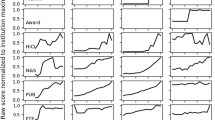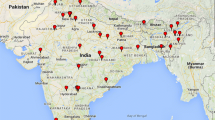Abstract
University rankings frequently struggle to delineate the separate contributions of institutional size and excellence. This presents a problem for public policy and university leadership, for example by blurring the pursuit of excellence with the quest for growth. This paper provides some insight into the size/excellence debate by exploring the explicit contribution of institutional size to the results of the Shanghai ranking indicators. Principal components analysis of data from the Shanghai ranking (2013 edition) is used to explore factors that contribute to the variation of the total score. The analysis includes the five non-derived ARWU indicators (Alumni, Award, HiCi, S&N and PUB) and uses the number of equivalent full-time academic staff (FTE) as a measure of size. Two significant but unequal factors are found, together explaining almost 85 % of the variance in the sample. A factor clearly associated with the size of the institution explains around 30 % of the variance. To sharpen the interpretation of the smaller factor as a measure of the effect of size, we extend the analysis to a larger set of institutions to eliminate size-dependent selection effects. We also show that eliminating outlying universities makes little difference to the factors. Our inferences are insensitive to the use of raw data, compared with the compressed and scaled indicators used by ARWU. We conclude that around 30 % of the variation in the ARWU indicators can be attributed to variation in size. Clearly, size-related factors cannot be overlooked when using the ranking results. Around 55 % of the variation arises from a component which is uncorrelated with size and which measures the quality of research conducted at the highest levels. The presence of this factor encourages further work to explore its nature and origins.





Similar content being viewed by others
References
Adcock, R., & Collier, D. (2001). Measurement validity: A shared standard for quantitative and qualitative research. The American Political Science Review, 95(3), 529–546.
Aghion, P., Dewatripont, M., Hoxby, C., Mas-Colell, A., & Sapir, A. (2008). Higher aspirations: An agenda for reforming European universities: Bruegel blueprint V. Downloaded from aei.pitt.edu on March 2, 2013. http://aei.pitt.edu/id/eprint/8714.
Bartlett, M. S. (1954). A note on the multiplying factors for various chi-square approximations. Journal of the Royal Statistical Society, 16(B), 296–298.
Billaut, J. C., Bouyssou, D., & Vincke, P. (2010). Should you believe in the Shangai ranking: An MCDM view. Scientometrics, 84(1), 237–263.
Boulton, G. (2010). University rankings: Diversity, excellence and the European initiative. Downloaded from www.leru.org on March 10, 2014. http://www.leru.org/files/publications/LERU_AP3_2010_Ranking.
Dehon, C., McCathie, A., & Verardi, V. (2010). Uncovering excellence in academic rankings: A closer look at the Shanghai ranking. Scientometrics, 83(2), 515–524.
Dickinson, C. (2009). Small but beautifully formed to compete. The Independent, 30.
Docampo, D. (2011). On using the Shanghai ranking to assess the research performance of university systems. Scientometrics, 86(1), 77–92.
Docampo, D. (2013). Reproducibility of the Shanghai academic ranking of world universities results. Scientometrics, 94(2), 567–587.
Docampo, D., & Cram, L. (2014). On the internal dynamics of the Shanghai ranking. Scientometrics, 98(2), 1347–1366.
Fellegi, I. (1975). Automatic editing and imputation of quantitative data. Journal of American Statistcs Association, 46, 249–253.
Flury, B. D. (1997). A first course in multivariate statistics. New York: Springer.
Gnanadesikan, R., & Kettenring, J. R. (1972). Robust estimates, residuals, and outlier detection with multiresponse data. Biometrics, 28, 81–124.
Grammaticos, B. (2007). The physical basis of scoring athletic performance. New Studies in Athletics, 22(3), 47–53.
Hawkins, D. M. (1974). The detection of errors in multivariate data using principal components. Journal of American Statistcs Association, 69, 340–344.
Hazelkorn, E. (2011). Rankings and the reshaping of higher education the battle for world-class excellence. Oxford: Palgrave Macmillan.
HECFE. (2008). Counting what is measured or measuring what counts? League tables and their impact on higher education institutions in England. Downloaded from www.hefce.ac.uk on September 20, 2013. www.hefce.ac.uk/media/hefce1/pubs/hefce/2008/0814/08_14.
IAAF. (2004). International Association of Athletics Federations scoring tables for combined events. Downloaded from the IAAF server on March 14, 2013. http://www.iaaf.org.
Jolliffe, I. T. (2002). Principal component analysis (2nd ed.). New York: Springer.
Kaiser, H. (1974). An index of factorial simplicity. Psychometrika, 39, 31–36.
Liu, N. C., & Cheng, Y. (2005). Academic ranking of world universities: Methodologies and problems. Higher Education in Europe, 30(2), 127–136.
Morrison, D. (2000). Multivariate statistical methods (3rd ed.). New York: McGraw-Hill.
Nokkala, T., Heller-Schuh, B., & Paier, M. (2011). Branking lists and European framework programmes: does university status matter for performance in framework programmes?. In P. N. Teixeira & D. D. Dill (Eds.), Public vices private virtues: Assessing the effects of marketization in higher education (Part 3, pp. 111–140). Boston: Sense.
Rao, C. (1964). The use and interpretation of principal component analysis in applied research. Sankhya A, 26, 329–358.
Rauhvargers, A. (2011). Global university rankings and their impact. European University Association report on rankings. http://www.eua.be/pubs/Global_University_Rankings_and_Their_Impact. Downloaded from the EUA server on April 30, 2013.
Ravallion, M., & Wagstaff, A. (2010). On Measuring scientific influence. World Bank policy research working paper no. 5375. Downloaded from the elibrary of the World Bank server on April 21, 2013. http://elibrary.worldbank.org/content/workingpaper/10.1596/1813-9450-5375.
Rawlings, H. R., Hilmer, F. G., Huber, B., et al. (2013). The ten characteristics of contemporary research universities. http://www.leru.org/files/news/Hefei_statement. Downloaded from www.leru.org on March 10, 2014.
Sawyer, K., Sankey, H., & Lombardo, R. (2013). Measurability invariance, continuity and a portfolio representation. Measurement, 46, 89–96.
Siganos, A. (2008). Rankings, governance, and attractiveness of higher education: The new French context. Higher Education in Europe, 33(2–3), 311–316.
Stevens, J. (1996). Applied multivariate statistics for the social sciences. Mahwah, NJ: Lawrence Erlbaum.
Tabachnick, B. G., & Fidell, L. S. (2007). Using multivariate statistics (5th ed.). Boston: Pearson Education/Allyn and Bacon.
Todorov, V., & Filzmoser, P. (2009). An object-oriented framework for robust multivariate analysis. Journal of Statistical Software, 32(3), 1–47.
van Raan, A. (2005). Fatal attraction: Conceptual and methodological problems in the ranking of universities by bibliometric methods. Scientometrics, 62(1), 133–143.
van Vught, F., & Ziegele, F. (2011). Design and testing the feasibility of a multidimensional global university ranking. Report commissioned by the Directorate General for Education and Culture of the European Commission. Consortium for Higher Education and Research Performance Assessment CHERPA-Network.
Verboven, S., & Hubert, M. (2010). Matlab library LIBRA. Wiley Interdisciplinary Reviews: Computational Statistics 04/2010, 2(4), 509–515.
Zitt, M., & Filliatreau, G. (2007). Big is (made) beautiful: Some comments about the Shangai ranking of world-class universities. In The world class universities and ranking: Aiming beyond status (Part 2, pp. 141–160). Romania: UNESCO-CEPES, Cluj University Press.
Zuur, A. F., Ieno, E. N., & Alphick, C. S. (2010). A protocol for data exploration to avoid common statistical problems. Methods in Ecology and Evolution, 1, 3–14.
Acknowledgments
The work of D. Docampo was supported by the European Regional Development Fund (ERDF) and the Galician Regional Government under agreement for funding the Atlantic Research Center for Information and Communication Technologies (AtlantTIC).
Author information
Authors and Affiliations
Corresponding author
Rights and permissions
About this article
Cite this article
Docampo, D., Cram, L. On the effects of institutional size in university classifications: the case of the Shanghai ranking. Scientometrics 102, 1325–1346 (2015). https://doi.org/10.1007/s11192-014-1488-z
Received:
Published:
Issue Date:
DOI: https://doi.org/10.1007/s11192-014-1488-z




